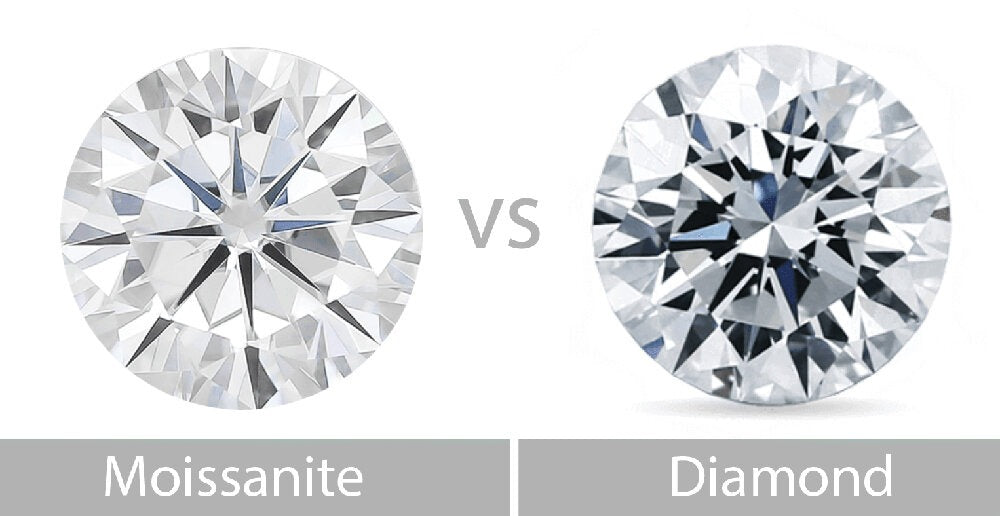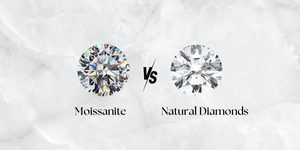To truly understand the difference between Moissanite and Lab diamond, we must discuss each individually. A lab diamond, also known as a synthetic diamond, is a man-made gem with a 10/10 hardness that is precisely like a natural diamond in composition. Visually identical, testing is the only method to tell them apart.
In contrast, some jewelry is made of synthetic Moissanite, a rare natural mineral typically found in microscopic crystals. As compared to Lab Diamonds, Moissanite is a combination of silica and carbon, giving it a unique brilliance and a somewhat lower hardness.
The appearance and hardness ratings of these minerals vary greatly. The only way to tell Lab Diamonds from mined diamonds is by using a specialized testing method.
However, for Moissanite, a completely different mineral, it has distinct shine and hardness properties that differentiates it from both Lab Diamonds and natural diamonds.
Lab-grown diamonds are favored over Moissanite due to ethical and environmental concerns in diamond mining, but Moissanite is equally sustainable and eco-friendly. Going ahead, we will decode various aspects of Moissanite vs Lab Grown Diamond in detail.
Moissanite vs Lab Grown Diamond
Below is the comparison of moissanite vs lab grown diamond on various aspects like compostions, hardness, appearance, durability and environmental effects.
Composition and Formation
Moissanite
The uncommon and valuable gemstone known as Moissanite is composed of silicon carbide, which has the chemical formula SiC and occurs naturally. Henri Moissan, a French chemist, discovered it in 1893.
Initially, a meteorite collision created it in space. The gemstone has value since it is rare. Even though Moissanite can be made in laboratories, its celestial body origins add to its attraction and distinctiveness.
Lab-Grown Diamonds
Since they are made entirely of carbon, diamonds may be produced artificially in labs as opposed to occurring naturally in the Earth's crust. Lab diamonds are produced using two main techniques: chemical vapor deposition, or CVD, and high pressure, high temperature, or HPHT.
These techniques produce real gemstones that are exactly like those found in nature.
A tiny diamond slice is subjected to high temperatures and carbon-rich gas during the CVD process, which causes the diamond to crystallize over several weeks.
While pure carbon inside a metal cube breaks down with high pressure and heat treatment (HPHT). It crystallizes into a rough diamond with a face-centered cubic lattice structure.
Appearance and Optical Properties
Moissanite
Moissanite is distinguished by its exceptional brilliance, which outshines diamonds in sparkle and vivid color. Remarkably, Moissanite has an astounding "dispersion" value of 0.104, twice the colored glitter of diamonds.
Its colorless, nearly colorless, and yellowish-green natural occurrence captivates spectators with a brilliant show similar to fireworks.
Because of its unique double refractive index, Moissanite has a refractive index of 2.65 to 2.69, twice that of natural diamonds. Due to the gem's brilliant rainbow flashes, which brilliantly reflect every color in the spectrum, Moissanite is an exceptional and radiant option.
Lab-Grown Diamonds
Lab Grown Diamonds usually have a dispersion value of 0.044, making them quite dazzling. These come in various colors, including "colorless," "near colorless," and rainbow tones like blue, red, or purple.
Chemically, physically, and optically, lab-grown diamonds are identical to their natural counterparts which are extracted from the Earth in terms of fire, scintillation, and brightness.
In contrast to natural diamonds, lab-grown diamonds exhibit a unique blend of brilliance, dispersion, and scintillation, which adds to their renowned radiance and indistinguishable characteristics from mined diamonds.
Durability and Hardness
Moissanite
On the Mohs Scale, Moissanite has an outstanding rating of 9.25/10, making it somewhat softer than diamonds. However, it is still a durable option without being impervious to scratches due to its remarkable resistance to abrasions. It is anticipated that jewelry made of Moissanite would shine and sparkle for years on end with adequate maintenance.
Lab-Grown Diamonds
The most challenging material on Earth, diamonds are rated a perfect 10 on the Mohs Scale and have extraordinary endurance. Lab-grown diamonds are as solid and complex as their mined counterparts and last for many generations to come.
Environmental Impact
Moissanite
Produced in controlled lab settings, Moissanite is ecologically friendly and sustainable. The thoroughly checked production process almost eliminates the likelihood of unethical behavior. Compared to natural diamonds, Moissanite has a smaller carbon footprint because it is a lab-grown stone and does not require mining or destruction of nature.
Lab-Grown Diamonds
People who value a controlled production environment free from unethical and environmental difficulties of diamond mining choose lab-grown diamonds over traditional diamonds. These diamonds are known as eco-friendly since they are grown in labs using advanced technical procedures. Unlike the irreversible damage caused by diamond mining, these stones are manufactured keeping morals in check and have no direct or indirect influence on the surrounding environment.
Cost and Affordability
Many questions arise regarding Moissanite vs Lab Diamond price; hence, in this segment, we have covered the aspect in detail.
Moissanite
When compared against Lab Diamonds, Moissanite turns out to be the less expensive choice. It is the most affordable and favored option for diamond alternatives at $599.00 for a 1.00ct and $1,500.00 for a 2.00ct. Due to its double refractive index, which gives it a mesmerizing disco-ball effect.
Moissanite is known for its durability and can be considered an equivalent to diamond. A 1-carat moissanite can be purchased for a price that varies according to quality and cut; it is a far less expensive option than a natural/lab-grown diamond.
Lab-Grown Diamonds
Lab Diamonds are more expensive because of their higher demand, classic charm, and increased hardness. Like genuine diamonds, they are priced in the range of $2,400–$4,300 for 1.00ct and $5,500–$6,500 for 2.00ct.
This pricing structure is based on the Four Cs: color, cut, clarity, and carat. However, lab-grown diamonds have a significant advantage over natural diamonds of the same size and quality, with savings of up to 40% for bigger carat weights and fancy-colored diamonds.
Ethical Considerations
Moissanite
In contrast to diamonds, which are associated with mining practices that may cause environmental harm and ethical dilemmas, Moissanite is a sustainable and righteous gemstone. Humanely methods are prioritized in the regulated laboratory conditions where Moissanite is generated. For those looking for a beautiful and ethical alternative to traditional diamond mining, Moissanite is a great solution.
Lab-Grown Diamonds
Diamonds created in laboratories, under carefully monitored conditions, ensure ethical labor standards and remove the possibility of endorsing inhumane mining activities. This ethical source reassures customers that their purchase does not support human exploitation or misery. The worries around "blood diamonds," or diamonds mined in conflict zones to finance violence, war operations, or conflicts, are reduced by lab-created diamonds, which are devoid of both blood and conflict.
Read more about moissanite vs natural diamonds
Buying Guide

A few factors need to be considered while choosing Moissanites vs lab-grown diamonds.
Put your creative preferences, ethical concerns, and financial constraints first. For many buyers, the fact that Moissanite is usually less expensive is a significant consideration.
The trend in the local market is another crucial reason. While lab-grown diamonds are becoming increasingly popular for engagement rings and fine jewelry, Moissanite is beginning to show promise as a more cost-effective option, particularly for younger Americans.
You might be able to decide by weighing each option's benefits and drawbacks. The renowned reputation, variety of colors, and ethical source of lab-grown diamonds are well-known. However, they are more expensive and have a lower market worth.
On the other hand, Moissanite is prized for its exceptional luminance, low cost, and environmental compatibility. On the other hand, it is considered lesser-known and has a slightly lower degree of hardness.
Aside from your partner's choices, personal preference is also very significant. Think about factors like size, shape, and appearance.
In addition, it's critical to consider components like the budget, moral standards, and environmental impact.
Before deciding, it's essential to consider your options and reach an informed conclusion. We are here to assist you in making this critical decision and ensure that you will be delighted with a gemstone that suits your tastes and values. Regardless of whether you prefer the classic beauty of lab-grown diamonds vs moissanites more affordable nature.
Check our top collections
- Oval Moissanite Rings
- Princess Moissanite Rings
- Radiant Moissanite Rings
- Moissanite Studs
- Moissanite Initial/Alphabet Necklace
- Solitaire Moissanite Engagement rings
FAQ
Q: Who Should Pick Moissanite?
Moissanite is an excellent choice for couples looking for a non-diamond center stone because it is sparkly, long-lasting, and affordable.
Q: Who Should Pick Lab Diamonds?
Lab Grown Diamonds are the best option for couples looking for a long-lasting, affordable, durable diamond with the same shine as mined diamonds and certified jewels.
Q: Can You Tell the Difference Between Moissanite vs Grown Diamond?
To understand the difference between Moissanite vs Lab Grown Diamond, only those who look closely enough will notice that the Moissanite ring has a distinctive colorful shimmer. However, Lab Diamonds are nearly indistinguishable from mined diamonds and lack any noticeable color luster.
Q: Where Can I Buy a Lab Diamond Engagement Ring or a Moissanite Engagement Ring?
Grownleo specializes in conflict-free, ethically sourced lab diamond and Moissanite engagement rings. We are experts in creating ethical engagement rings with various stones, including lab diamonds and Moissanite.
Q: Can you help me choose between Moissanite vs Lab Grown Diamond?
Absolutely! Make the proper choice between Moissanite vs Lab Grown Diamond with the help of a gemologist at Grownleo. Please get in touch with us by email at support@grownleo.com.
Q: Is Moissanite a lab diamond?
No, Moissanite is not a lab diamond. Even though both are created in laboratories, Moissanite and lab diamonds are made of different materials and have different properties. The mineral known as Moissanite, made of silicon carbide, is unique from diamonds in terms of composition and structure.






